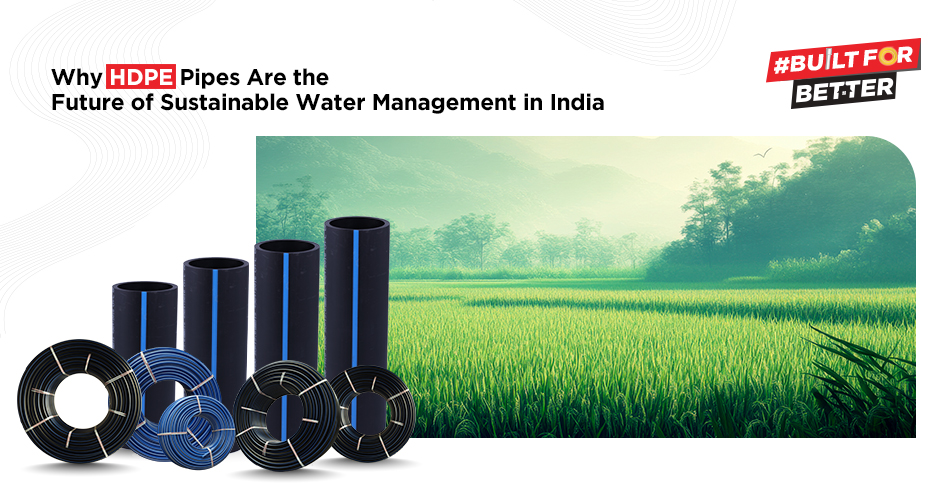India’s water woes aren’t a secret. Leaky pipes, crumbling infrastructure, and growing demand have left cities and villages scrambling for solutions. Enter HDPE pipes – tough, eco-friendly, and built to last. These high-density polyethylene pipes are shaking up how we handle water supply, irrigation, and drainage. So, why are they the future of sustainable water management in India? Let’s explore and see what makes them stand out.
The Eco-Friendly Edge
HDPE pipes have a blue or black streak that’s hard to ignore. Unlike traditional metal or concrete pipes, they’re made from a plastic that’s recyclable. When their long life finally ends – 50 to 100 years – HDPE pipe manufacturers can melt them down and turn them into something new. In a country like India, where landfills are overflowing and resources are stretched thin, this matters. Plus, making HDPE pipes uses less energy than forging steel or curing concrete. Lower carbon footprint? Check.
No Leaks, No Worries
Ever seen water gushing out of a cracked pipe in the middle of a busy street? It’s a mess – and a waste. HDPE pipes dodge that problem with their leak-free joints. They’re fused together using heat, creating a seamless bond that doesn’t budge. No gaps, no leaks. Studies say traditional pipes lose up to 30% of water through leaks in India’s aging networks. With HDPE pipes, that number drops hard. For a nation where every drop counts – especially in drought-prone spots like Rajasthan or Tamil Nadu.
Built to Last
HDPE pipes don’t mess around when it comes to durability. They dismiss issues like rust, corrosion, and harsh chemicals in the soil. What about metal pipes? They rot away over time. Concrete? It cracks. But an HDPE pipe keeps going strong for decades. Some experts peg their lifespan at over 70 years with proper care. That’s huge for India, where fixing busted infrastructure eats up budgets. Whether it’s piping water to a remote village or handling urban drainage, HDPE pipe manufacturers deliver products that last.
Perfect for India’s Tough Terrain
India’s landscape is wild – rocky hills, sandy plains, monsoon-soaked fields. HDPE pipes can take it all. They’re lightweight and flexible, so they bend without breaking. That makes them a dream for tricky installs, like laying irrigation lines across uneven farmland or snaking water pipes through crowded cities. Compare that to rigid metal pipes that need heavy machinery and extra manpower. HDPE pipe manufacturers know this flexibility is a win, especially for rural projects where budgets and equipment are tight.
Saving Water in Farms and Cities
HDPE pipes are revolutionizing water delivery across India. Designed for maximum flow with minimal friction, these pipes ensure water reaches farms and cities efficiently with no wasted pressure or leaks. For farmers, this means more reliable irrigation without extra energy costs. In urban areas, it translates to cleaner drinking water with fewer losses. In water-stressed regions like Punjab, where agriculture consumes 80% of supplies, HDPE’s leak-proof joints could dramatically stretch existing resources. By delivering water precisely where it’s needed, this modern piping solution helps conserve India’s most precious resource while boosting productivity.
Low Maintenance, Big Savings
HDPE pipes barely need upkeep. Once they’re in the ground, you can pretty much forget about them. No rust to scrub, no cracks to patch. That’s a stark contrast to older systems that need constant repairs. A report from the Central Water Commission pegged India’s water infrastructure repair costs at billions of rupees yearly. HDPE pipes could slash that number and free up money for other business needs.
Tackling India’s Water Crisis Head-On
India’s staring down a water crunch. By 2030, demand could outstrip supply by 50%, says the government’s own estimates. Aging pipes and wasteful systems aren’t helping. HDPE pipes step up here – they’re not just a fix, they’re a lifeline. From massive urban projects like Delhi’s water grid to tiny drip irrigation setups in Maharashtra, HDPE pipe manufacturers are proving their worth. They’re scalable, affordable, and tough enough to handle India’s chaos.
The Cost Question
Sure, HDPE pipes might cost a bit more upfront than some alternatives. But zoom out, and the math checks out. Their long life and low maintenance mean you’re not shelling out for replacements or fixes every few years. Plus, the water savings add up fast. For a farmer or a city planner, that’s money in the bank. HDPE pipe manufacturers often point to this tradeoff – pay a little now, save a lot later. In a country where every rupee counts, that’s a pitch that sticks.
Government Initiatives
The Indian government’s on board too. Schemes like Jal Jeevan Mission, aiming to pipe clean water to every rural home, lean on durable options like HDPE pipes. Why? They’re quick to install, last forever, and don’t poison the water with rust or leaks. HDPE pipe manufacturers are ramping up to meet this demand, churning out pipes that fit the bill for both small villages and sprawling cities.
Wrap Up
HDPE pipes aren’t just pipes – they represent a shift in approach. They’re green, tough, and ready to tackle India’s water challenges head-on. From cutting waste to stretching resources, they check all the boxes for sustainable water management. Whether it’s a farmer irrigating fields or a city fixing its leaky mains, HDPE pipe manufacturers have the goods to make it work. India’s future needs water solutions that last, and HDPE pipes are stepping up to the plate.


